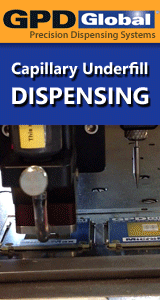| | What is the level of interest in bulk feeding cpassive devices, caps & resistors, 0402,0603,0805? The component mfgs. tell me in 3 years 40% of the passive caps will be bulk fed. Their is currently about a 10% cost savings with bulk over tape & reel and that number will surely grow as volumes increase, and no scrap! So why the lack of interest? | A wishful thinking of the component mfgs! | The machine suppliers prepared themself with | different designed bulk feeders ( I like the | Sanyo design best ) and expecting the customers | of testing their products. | With some of the bulk feeders I experienced an | impact on the pick up reliability due to the more complicated mechanic of the bulk feeders. | Tape feeders have a 15 years and more proven and | improved mechanic. I expect it will take at least five years of customer feedback on bulk feeders until all the "bugs" get resolved. I see a lot of interest in bulkfeeding, just not a lot of companies that have actually implimented it. The issue is not feeder reliability (a well designed bulkfeeder will run at mispick PPM levels down to 1/10th that of a comparable tape feeder). The real issue is the complex logistics of implimenting bulk feeding across an entire factory. If bulkfeeding is not supported by all vendors placement machines (and with the same casette standard) the logistics of having to stock components in tape AND bulk are cost prohibitive. Not all pick and place manufacturers have been successful yet in developing bulkfeeders. Bulk is without a doubt the way to go for high volume assembly of boards with high chip counts of 0402-0805 parts. Feeder jams are minimized, and intervals between parts replenishment can be greatly increased. (0402 bulk casettes hold > 50k chips each, which is equal to (5) 7" reels). These are the 2 main influences on practical machine efficiencies. Additionally, storage areas for component inventories can be significantly reduced in size. The never-ending drive to reduce the cost of electronic products should logically push the industry in the direction of bulkfeeding for high volume assembly environments.
reply »
![]()
![]() What is the level of interest in bulk feeding cpassive dev...
- Jun 23, 1998
by
What is the level of interest in bulk feeding cpassive dev...
- Jun 23, 1998
by
![]()
![]() | What is the level of interest in bulk feeding cpassive d...
- Jun 23, 1998
by
| What is the level of interest in bulk feeding cpassive d...
- Jun 23, 1998
by
![]()
![]() | A wishful thinking of the component mfgs!
| The machine...
- Jun 24, 1998
by
| A wishful thinking of the component mfgs!
| The machine...
- Jun 24, 1998
by
![]()
![]() Does the current Panasonic / KME bulk feeder design use th...
- Jun 29, 1998
by
Does the current Panasonic / KME bulk feeder design use th...
- Jun 29, 1998
by
![]()
![]() | | What is the level of interest in bulk feeding cpassi...
- Jul 10, 1998
by
| | What is the level of interest in bulk feeding cpassi...
- Jul 10, 1998
by
 hitech.gif)



.gif)


